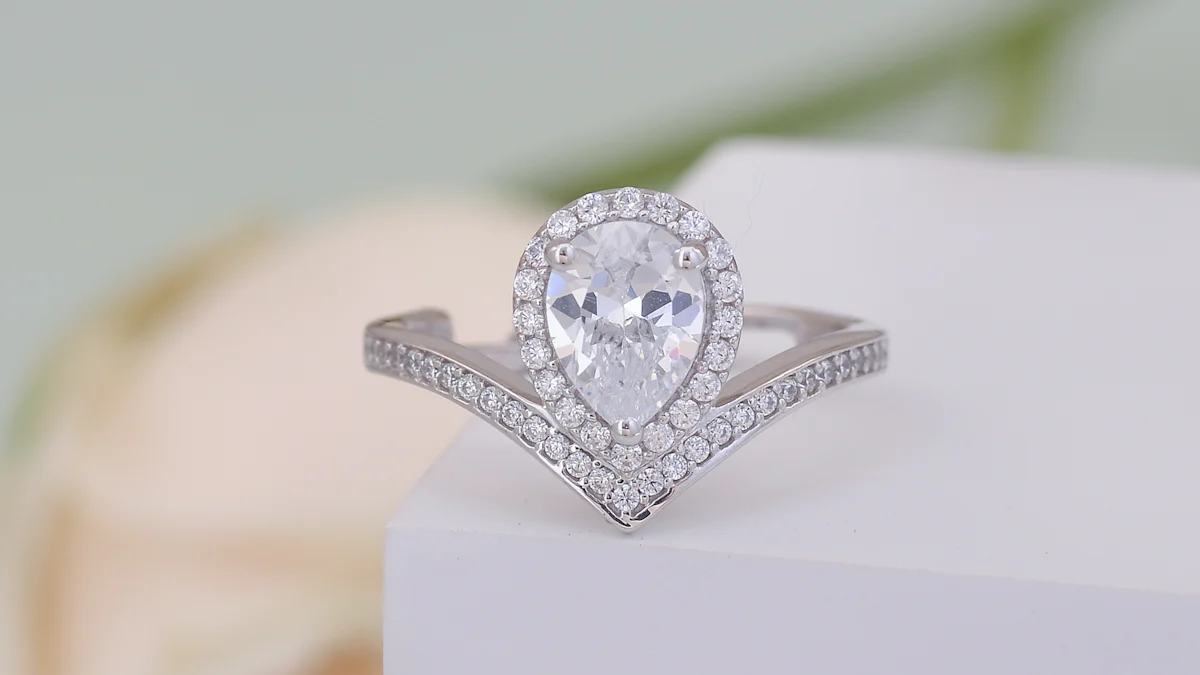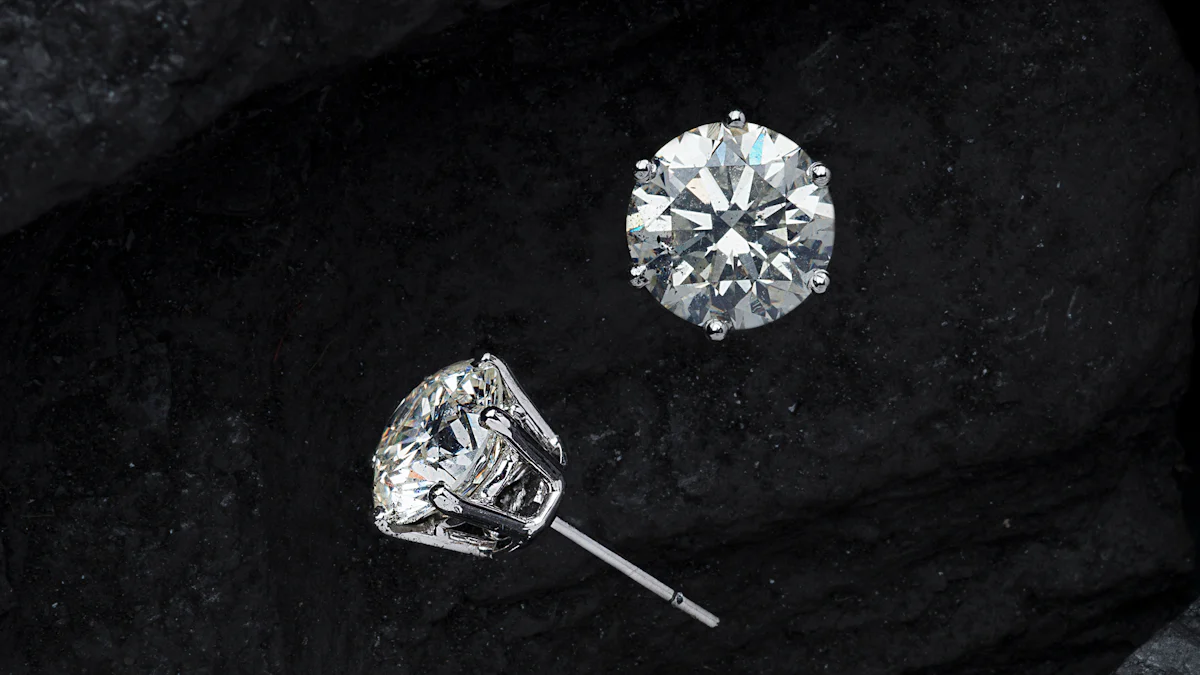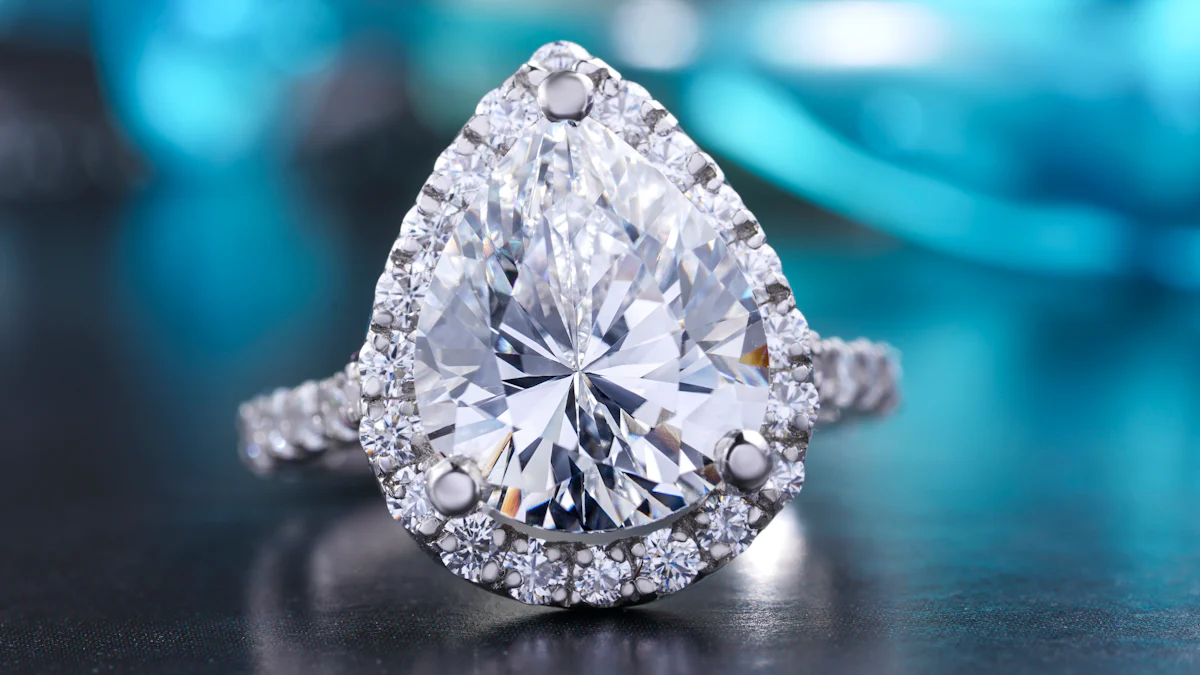Understanding 2 Carat Diamond Costs

When you consider purchasing a 2 carat diamond, you might wonder about the cost. Typically, prices range from $8,000 to $50,000. This wide range reflects variations in quality and market factors. The 4Cs—cut, clarity, color, and carat weight—play a significant role in determining the price. For instance, a well-cut diamond with high clarity and color grades can command a premium price. Additionally, market conditions and the rarity of finding enough raw material for a 2 carat diamond also influence costs. Understanding these factors helps you make informed decisions when exploring how big is a 2 carat diamond.
Key Takeaways
- Understand the 4Cs: The cut, clarity, color, and carat weight are crucial in determining a diamond's price. Prioritize these based on your preferences and budget.
- Consider lab-grown diamonds: They are typically 30% to 50% less expensive than natural diamonds, offering a sustainable and affordable alternative without sacrificing quality.
- Explore cost-effective settings: Simple settings like solitaire or halo can enhance the diamond's appearance while keeping costs manageable.
- Monitor market conditions: Prices can fluctuate based on supply and demand, so timing your purchase during sales or favorable market trends can lead to significant savings.
- Negotiate with jewelers: Don't hesitate to ask for price matching or bundle deals to maximize your investment when purchasing a diamond.
- Visualize the size: A 2 carat diamond measures about 8.1 millimeters in diameter, making it a noticeable and elegant choice for jewelry.
- Compare carat weights: The price per carat increases significantly with size, so weigh the visual impact against the cost when considering larger diamonds.
Factors Influencing 2 Carat Diamond Costs

The 4Cs: Cut, Clarity, Color, and Carat
The 4Cs—cut, clarity, color, and carat weight—are the primary factors that determine a diamond's price. Each of these characteristics plays a crucial role in the overall value of a 2 carat diamond.
How Cut Affects Price
The cut of a diamond significantly impacts its price. A well-cut diamond reflects light beautifully, enhancing its brilliance and sparkle. You will find that diamonds with excellent cuts often command higher prices because they maximize the stone's visual appeal.
The Impact of Clarity on Cost
Clarity refers to the presence of internal or external flaws, known as inclusions and blemishes. Diamonds with fewer inclusions are rarer and more valuable. When you choose a diamond with high clarity, you are likely to pay a premium for its near-perfect appearance.
Color Grading and Its Influence on Value
Color grading assesses how colorless a diamond is. The less color a diamond has, the more valuable it becomes. You should consider diamonds with higher color grades if you want a stone that appears whiter and more brilliant.
Carat Weight and Its Role in Pricing
Carat weight measures a diamond's size. Larger diamonds are rarer, making them more expensive. As you look at 2 carat diamonds, remember that the price per carat increases with size, reflecting the rarity of larger stones.
Diamond Shape and Its Effect on Cost
The shape of a diamond also influences its cost. Different shapes have varying levels of popularity and demand, affecting their market value.
Popular Shapes and Their Price Differences
Round diamonds are the most popular and often the most expensive due to their brilliance and demand. Other shapes like princess, oval, and cushion may offer more affordable options while still providing stunning beauty.
Uncommon Shapes and Their Market Value
Uncommon shapes, such as marquise or pear, can be less expensive due to lower demand. However, these unique shapes can offer a distinctive look that sets your diamond apart.
Market Conditions and Economic Factors
Beyond the 4Cs and shape, market conditions and economic factors also play a role in diamond pricing.
Supply and Demand Dynamics
The availability of diamonds and consumer demand directly affect prices. When demand is high and supply is limited, prices tend to rise. You should keep an eye on these dynamics when planning your purchase.
Global Economic Trends
Global economic trends can influence diamond prices. Economic downturns may lead to lower demand and prices, while economic booms can drive prices up. Staying informed about these trends can help you make a strategic buying decision.
Tips for Purchasing a 2 Carat Diamond
Consider Lab-Grown Diamonds
Lab-grown diamonds offer a compelling alternative to natural diamonds. They share the same optical, physical, and chemical qualities as mined diamonds, making them indistinguishable to the naked eye.
Benefits of Lab-Grown Diamonds
- Affordability: Lab-grown diamonds typically cost 30% to 50% less than natural diamonds. This price difference allows you to purchase a larger or higher-quality stone within your budget.
- Sustainability: These diamonds are produced in controlled environments, reducing the environmental impact associated with traditional mining. Choosing lab-grown diamonds supports ethical sourcing and sustainability.
- Availability: Lab-grown diamonds are becoming more widely available in various sizes and shapes, offering you more options to suit your style.
Cost Comparison with Natural Diamonds
When comparing costs, a 2 carat lab-grown diamond can be significantly cheaper than its natural counterpart. For example, while a natural diamond might range from $8,000 to $50,000, a lab-grown diamond of similar quality could cost between $2,990 and $6,060. This substantial saving makes lab-grown diamonds an attractive option for those seeking value without compromising on quality.
Explore Alternative Settings
The setting of your diamond can greatly influence the overall cost of your purchase. Exploring alternative settings can help you manage expenses while still achieving a stunning look.
Cost-Effective Setting Options
- Solitaire Settings: Simple and elegant, solitaire settings highlight the diamond itself and often cost less than more intricate designs.
- Halo Settings: Surrounding the center diamond with smaller stones can enhance its appearance and make it look larger, providing a cost-effective way to add sparkle.
Enhancing Appearance Without Increasing Cost
- Prong Settings: These settings allow more light to enter the diamond, enhancing its brilliance without adding to the cost.
- Bezel Settings: Offering a modern look, bezel settings securely hold the diamond and can make it appear larger.
Strategies for Getting the Best Value
To maximize your investment, consider these strategies when purchasing a 2 carat diamond.
Timing Your Purchase
- Seasonal Sales: Look for sales during holidays or special events when jewelers may offer discounts.
- Market Trends: Monitor diamond market trends to identify the best time to buy, as prices can fluctuate based on supply and demand.
Negotiating with Jewelers
- Price Matching: Some jewelers may match or beat competitors' prices, so don't hesitate to ask.
- Bundle Deals: Inquire about discounts for purchasing multiple items, such as a diamond and a setting together.
By considering these tips, you can make an informed decision and find a 2 carat diamond that fits your budget and preferences.
Comparing 2 Carat Diamond Prices to Other Carat Weights
Price Differences Between Carat Weights
1 Carat vs. 2 Carat Diamonds
When you compare 1 carat and 2 carat diamonds, you'll notice a significant price difference. The cost of a diamond doesn't increase linearly with its carat weight. Instead, it jumps exponentially. A 2 carat diamond is significantly more expensive than a 1 carat diamond. For instance, a 1 carat diamond might be priced at $2,680 or more per carat, while a similar 2 carat diamond could be at $6,240 or more per carat. This exponential increase reflects the rarity and desirability of larger stones.
2 Carat vs. 3 Carat Diamonds
The price difference between 2 carat and 3 carat diamonds follows a similar pattern. As the carat weight increases, the price per carat rises sharply. A 3 carat diamond will cost significantly more than a 2 carat diamond. This is due to the increased rarity and the higher demand for larger diamonds. When considering a purchase, you should weigh the visual impact against the substantial cost increase.
Understanding Price Per Carat
How Price Per Carat Changes with Size
The price per carat of diamonds changes as the size increases. Larger diamonds are rarer, which makes them more valuable. As you move up in carat weight, the price per carat tends to rise. This means that a 2 carat diamond will cost more per carat than a 1 carat diamond. This pricing structure reflects the scarcity and desirability of larger stones.
Economies of Scale in Diamond Pricing
In diamond pricing, economies of scale don't apply in the traditional sense. Instead, the opposite occurs. As the carat weight increases, the price per carat also increases. This is because larger diamonds are rarer and more sought after. When you purchase a larger diamond, you're paying a premium for its size and rarity. Understanding this can help you make informed decisions when comparing different carat weights.
How Big is a 2 Carat Diamond?

When you think about how big is a 2 carat diamond, imagine a stone that truly stands out. A 2 carat diamond is not just a piece of jewelry; it is a statement. Its size makes it eye-catching and significant, especially when compared to the average engagement ring in the United States, which typically ranges between 1.00 and 1.20 carats. This larger size gives the diamond an undeniable presence, making it a popular choice for those who want their ring to be noticed.
Visualizing the Size of a 2 Carat Diamond
To visualize how big is a 2 carat diamond, consider its diameter. A well-cut round 2 carat diamond usually measures about 8.1 millimeters across. This size allows the diamond to capture and reflect light beautifully, enhancing its brilliance and sparkle. When you wear a 2 carat diamond, it becomes a focal point, drawing attention with its impressive size and shine. The diamond's substantial size also allows for intricate settings that can further enhance its appearance, making it a versatile choice for various ring designs.
Comparing Size to Other Carat Weights
When comparing how big is a 2 carat diamond to other carat weights, the difference becomes clear. A 1 carat diamond, for example, measures approximately 6.5 millimeters in diameter. Although beautiful, it lacks the commanding presence of a 2 carat stone. On the other hand, a 3 carat diamond, which measures around 9.3 millimeters, offers even more impact but comes with a significantly higher price tag. The 2 carat diamond strikes a balance between size and cost, providing a luxurious look without being overly extravagant. This makes it an appealing choice for those who want a diamond that is both elegant and noticeable.
Choosing a 2 carat diamond offers several benefits. Its size is large enough to catch attention and make a statement, yet it remains elegant and not overly showy. This balance makes it a favored option for many seeking a perfect blend of beauty and sophistication.
Understanding the cost factors of a 2 carat diamond helps you make informed decisions. The 4Cs—cut, clarity, color, and carat weight—are crucial in determining price. Prioritize these based on your preferences and budget. Consider the carat weight as it significantly impacts cost. Explore personalized options to find a ring that suits your style. When you know how big is a 2 carat diamond, you can better appreciate its value and presence. Balancing these elements ensures you choose a diamond that meets your needs and expectations.
FAQ
How much does a 2 carat diamond cost?
The cost of a 2 carat diamond can vary widely. You might find prices ranging from $4,300 to $75,000. The median price often sits around $18,200. These variations depend on the diamond's quality, which is determined by the 4Cs: cut, clarity, color, and carat weight.
What factors influence the price of a 2 carat diamond?
Several factors influence the price of a 2 carat diamond. The 4Cs—cut, clarity, color, and carat weight—play a significant role. Additionally, the diamond's shape and market conditions can affect its cost. Businesses like James Allen and Blue Nile provide price charts to help you assess these factors.
How big is a 2 carat diamond?
A 2 carat diamond typically measures about 8.1 millimeters in diameter if it is round. This size makes it a noticeable and eye-catching choice for jewelry. Its substantial size allows it to reflect light beautifully, enhancing its brilliance and sparkle.
How does the price per carat change with size?
The price per carat increases as the diamond's size increases. Larger diamonds are rarer, making them more valuable. For example, a 2 carat diamond costs significantly more per carat than a 1 carat diamond. This pricing reflects the scarcity and desirability of larger stones.
Are lab-grown diamonds a good alternative?
Yes, lab-grown diamonds offer a compelling alternative. They share the same optical, physical, and chemical properties as natural diamonds. Lab-grown diamonds typically cost 30% to 50% less, making them an affordable option without compromising quality.
What should you consider when buying a 2 carat diamond?
When buying a 2 carat diamond, consider your budget and the quality you desire. A good-quality 2 carat round diamond might cost between $14,000 and $17,000. If you prefer a fancy shape, like a cushion-cut, expect to pay between $11,000 and $15,000. For higher quality, aim for a D-G color and VS1 or above clarity.
How do market conditions affect diamond prices?
Market conditions, including supply and demand dynamics, significantly impact diamond prices. High demand and limited supply can drive prices up. Global economic trends also play a role. Economic downturns might lower demand and prices, while booms can increase them.
Can you negotiate the price of a 2 carat diamond?
Yes, negotiating the price is possible. Many jewelers offer price matching or bundle deals. Don't hesitate to ask for discounts, especially if you're purchasing multiple items like a diamond and its setting together.
What are some cost-effective settings for a 2 carat diamond?
Cost-effective settings include solitaire and halo designs. Solitaire settings highlight the diamond and often cost less. Halo settings surround the center diamond with smaller stones, enhancing its appearance and making it look larger without a significant cost increase.
How does the shape of a diamond affect its cost?
The shape of a diamond affects its cost due to varying levels of popularity and demand. Round diamonds are the most popular and often the most expensive. Other shapes, like princess or oval, may offer more affordable options while still providing stunning beauty.
See Also
What is the Price of a 2 Carat Lab Diamond
Comparing Prices of All Around Diamond Rings
Essential Elements Influencing Diamond Ring Costs

